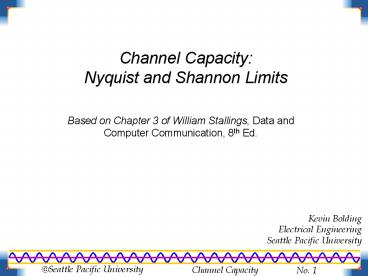Channel Capacity: Nyquist and Shannon Limits - PowerPoint PPT Presentation
1 / 8
Title:
Channel Capacity: Nyquist and Shannon Limits
Description:
... an easier time corrupting bits. 2 levels - better margins. 4 levels - noise corrupts data. Channel Capacity ... Noise is only a problem when it corrupts data ... – PowerPoint PPT presentation
Number of Views:1716
Avg rating:3.0/5.0
Title: Channel Capacity: Nyquist and Shannon Limits
1
Channel CapacityNyquist and Shannon Limits
- Based on Chapter 3 of William Stallings, Data and
Computer Communication, 8th Ed.
Kevin BoldingElectrical EngineeringSeattle
Pacific University
2
Nyquist Limit on Bandwidth
- Find the highest data rate possible for a given
bandwidth, B - Binary data (two states)
- Zero noise on channel
Example shown with bandfrom 0 Hz to B Hz
(Bandwidth B)Maximum frequency is B Hz
Period 1/B
- Nyquist Max data rate is 2B (assuming two signal
levels) - Two signal events per cycle
3
Nyquist Limit on Bandwidth (general)
- If each signal point can be more than two states,
we can have a higher data rate - M states gives log2M bits per signal point
Period 1/B
4 signal levels 2 bits/signal
- General Nyquist Max data rate is 2B log2M
- M signal levels, 2 signals per cycle
4
Practical Limits
- Nyquist Limit based on the number of signal
levels and bandwidth - Clever engineer Use a huge number of signal
levels and transmit at an arbitrarily large data
rate
- The enemy Noise
- As the number of signal levels grows, the
differences between levels becomes very small - Noise has an easier time corrupting bits
5
Characterizing Noise
- Noise is only a problem when it corrupts data
- Important characteristic is its size relative to
the minimum signal information
- Signal-to-Noise Ratio
- SNR signal power / noise power
- SNR(dB) 10 log10(S/N)
- Shannons Formula for maximum capacity in bps
- C B log2(1 SNR)
- Capacity can be increased by
- Increasing Bandwidth
- Increasing SNR (capacity is linear in SNR(dB) )
SNR in linear form
Warning Assumes uniform (white) noise!
6
Shannon meets Nyquist
Example To support 16 levels (4 bits), we need a
SNR of 255 (24 dB)
Example To achieve Shannon limit with SNR of
30dB, we need 32 levels
7
Achieving the Nyquist Limit
- The Nyquist Limit requires two signaling events
per Hertz - C2B log2M
- This must be achieved using waveforms with
frequency components lt B
Period 1/B
Corners require higher-frequency components
- We need a way to represent a 1 with a pulse
that has no components greater than B - Must be able to overlap two pulses per Hertz
without loss of information
8
Sinc (Nyquist) Pulses
- The Sinc Pulse is defined as sin(x)/x
- Sinc pulse at frequency f requires bandwidth f
- sin(x 2?f)/(x 2?f)
- Note that the sinc pulse is zero at all multiples
of 1/2f except for the singular pulse
- Pulses can overlap as long as each one is
centered on a multiple of 1/2f
- When the pulses are summed, checking the waveform
at each multiple of 1/2f gives the orignal data

